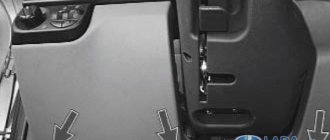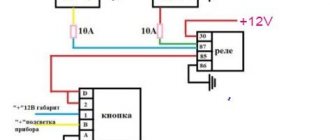The main reasons why the battery may not charge
To understand in detail all the possible malfunctions due to which the car battery does not charge, first of all, clearly define the situation:
| The battery quickly discharges and dies | or he | does not charge at all (does not accept charge) |
In general, when the battery refuses to charge, the following options are allowed:
- plate sulfation;
- destruction of plates;
- terminal oxidation;
- decrease in electrolyte density;
- short circuit
But you shouldn’t worry so much right away, everything is not always so bad, especially if such a problem arose while driving (indicated by a red battery light). It is necessary to consider special cases in which the car battery does not take charge only from the generator or from the charger as well.
The charging system of a car battery contains a number of external devices, on which the performance of the battery itself and the charging process can also greatly depend. To check all external devices, you will need a multimeter (tester); it will allow you to measure the voltage at the battery terminals under different engine operating modes. You will also have to check the generator. But this is only true when the battery does not want to be charged from the generator. If the battery does not take a charge from the charger, then it is advisable to also have a hydrometer to check the density of the electrolyte.
What is the alternative?
Not everyone has advanced chargers. However, people now have a lot of different gadgets and some purchase universal chargers that allow them to charge different types of batteries. Including lead-acid. A restorative charge can be made with their help. It is quite possible that there is a special mode for this, but ample settings allow you to select it manually. At least, it is possible to set a small current of 0.03*C─0.1*C and trigger when a certain voltage is reached in them.
The battery is completely discharged and will not charge
Details Category: iron Published 04/27/2017 11:00 Author: Zorych
Remember: never discharge modern gadgets to zero. In principle, there is nothing dangerous about this. Deep discharge into which lithium-ion and lithium-polymer batteries can enter is dangerous. And this is not fatal, but reviving such a gadget is not so easy. I haven't succeeded yet (succeeded with the help of flashing).
Six months ago we had to get to an overnight stay somewhere in Crimea. I used the Highscreen Power Five EVO smartphone as a navigator. I connected it to the car's on-board power supply, but the smartphone discharged faster than it charged. Finally, it turned off and refused to charge. Even from the original charger. Fortunately, after letting the phone sit for two days, it started charging again.
The other day the smartphone died under the same circumstances. Now it lies in front of me and refuses to charge. I tried two different chargers, four cables. I tried to charge from the computer. Everything is in vain. I left it on charge overnight with no success.
Modern gadgets have protection against deep discharge: when a certain minimum threshold is reached, the device automatically turns off. Therefore, in principle, you can safely bring your phone or tablet to zero percent. It will turn off on its own, leaving the necessary charge. But in my case, it could not turn off as it continued to charge. Due to the fact that the charge current was less than the discharge current, the smartphone battery went into a deep discharge. Where he remains to this day. The charge controller seems to have cut off the power circuit and is preventing it from charging.
If you have a removable battery, you can remove it from the smartphone, connect the smartphone to the charger and after 10-15 minutes insert the battery. Charging should start. You can charge the battery separately using a frog. You can try attaching two wires to the battery terminals for a direct charge and applying 3.7-4.2 V (if you don’t know how to do this, don’t try it yourself). You only need to charge the battery 5-10%, and then charge it as usual
Alas, the Highscreen Power Five EVO has a non-removable battery. It can be pulled out, but there are no classic terminals here - power is supplied using a thin cable. I can't seem to cope with this on my own. You'll have to turn to specialists. If I had a regular removable battery, I would try to charge it using a “frog” (universal charger).
The battery is low and will not charge. What to do?
This question is faced by many people who use rechargeable batteries in one way or another. Of course, this question can be answered unequivocally only after a thorough diagnosis of the battery by specialists, but something can be done independently without using complex expensive diagnostic devices.
A common reason that the battery is discharged and does not charge is not even the battery itself, but the charger that is used to charge it, and here’s the thing:
Some chargers have protection in case you turn on the charger and do not connect the battery to it for recharging. Therefore, in order for the charger to start generating current and directing it for charging, it, this charger, must see a battery at its output. The charger can determine the presence of a battery only by the presence of voltage between the terminals. Moreover, this voltage must be above a certain limit. The level of this minimum threshold is different for different charges and, as a rule, can start from 9-10V. Thus, if the voltage between the battery terminals is below these 9-10 Volts, the charger simply will not see it, and therefore will not start charging.
What to do in such a situation?
The most obvious option for reviving the battery is to find a charger without such protections - as a rule, these are the cheapest chargers that simply create a voltage between the battery terminals of 14.5 Volts and begin to pump current. However, you need to be very careful here, because if you start charging a deeply discharged battery with a high current at once, this can completely kill it. Therefore, you need to start reviving the battery with low currents significantly less than the usual charging current, which is 1/10C (1/10 of the battery capacity). For example, a 60Ah battery can be revived with a current of 1-2A.
Overview of the device
Lead acid batteries were invented more than 150 years ago. Since its invention, the design has remained virtually unchanged. The box contains lead plates (minus) and lead dioxide (plus). A dielectric is poured between them. It prevents the plates from shorting.
Packs of plates are placed in electrolyte. As a rule, there are 6 packs (cans) in a standard battery. Each produces a voltage of about 2.1 Volts.
The battery is quite durable and resistant to mechanical damage. But it has a weak point - the electrolyte. Due to sulfuric acid, when deeply discharged, the battery becomes inoperable. But the second component of the electrolyte, distilled water, has a negative effect on the battery when recharging.
Method 3
This method is applicable for batteries that show no signs of life at all, i.e. their output is 0 volts. You can check this with a voltmeter, or, in its absence, using the traditional “taste” method. Don’t think that this battery is probably dead and it’s time to run to the store for a new one.
There is a method, but it requires basic electronics skills and is fraught with risks. If you reverse the polarity or use a more powerful power supply than intended, you can even explode the battery. If you are not sure, go to the service center.
You will need a 4-5 volt power supply, no more. Connect the battery from this power supply, observing the polarity, for up to 1 minute. Such an impulse will be enough for the built-in battery controller to work and begin charging using the first or second method.
October 29, 2014
Oleg Vend
Usually a smartphone or cell phone, an experienced traveler takes an external battery out of his backpack, and a city dweller looks for an outlet with his eyes. But what if you find yourself outside the city in a critical situation, and your communication device suddenly turns off? There are several sometimes controversial methods for doing this.
I warn you right away - any methods for a few minutes most often at least end in loss of battery. However, sometimes it comes down to life or health, and losing a battery is the simplest thing that can happen in such a situation. Therefore, the material will not be superfluous - at least it will make you think about providing backup power.
1. The first controversial method is to remove the battery and place it against something hot. A couple of minutes - and it allows you to turn on the phone and make a minute call to the Ministry of Emergency Situations or to friends. In any case, this method is not for smartphones - they only boot up a couple of minutes after turning on. I haven’t tried it myself, but a survival specialist I know said that this is possible with some types of batteries. Personally, I’m not sure about this, and when the time comes to throw away the next battery, I’ll try this method on it first.
2. The second controversial method is to remember how ordinary batteries are revived. To be honest, I don’t know what types of telephone batteries this works on, but there is an opinion that if you tap the battery properly on a hard object, it will allow you to make at least one short call.
3. The third option, they say, can also work. Some people believe that the battery can be charged with static electricity. That is, if you rub the battery, for example, on a fur coat for several minutes, you will gain a small amount of energy for an emergency call.
4. The fourth method works, but not on all smartphones. And it can also lead to the loss of the battery, but we are talking about an emergency, so we won’t waste time on trifles. So, we remove the battery, find a piece of paper and insert the battery into place, closing the BSI contact. In smartphones this is the middle contact.
This method allows you to “deceive” the smartphone controller, since the device now cannot determine how charged the battery is. Since the batteries cannot be discharged to 100%, the phone usually turns off when a certain minimum is reached. Accordingly, now it will turn on and you can make calls until it is completely discharged. True, after this the battery will only have to be thrown away.
In addition, fire or short circuits are likely, so be prepared for trouble. The battery may swell and crystallize. But if an emergency call can save a person’s life or health, then in comparison the loss of a smartphone or battery is a mere trifle.
Do you know any way to bring the battery back to life for at least a couple of minutes?
?
Share with our readers - perhaps in this way you will take part in saving someone’s life in a suburban accident or after a plane crash
.
If you have your own experience or thoughts, we are also waiting for you in the comments. Thank you!
Falls into a state called deep discharge. And then the controller monitoring its parameters turns off the battery and makes further operation impossible. How to charge a completely discharged phone battery, thereby breathing new life into it? There are several ways to do this.
It is possible to “revive” a completely discharged battery.
First, let's look at a method that uses a twelve-volt power supply and a resistor of about 500 Ohms with a power of 50 mW or more. To push, you need to short-circuit the battery with the block for two to three minutes, connecting the minus of the device to the minus of the block, and the plus to the plus, respectively, but through a resistor (!).
The supplied voltage must be controlled. A tester or voltmeter is used for this purpose. And the polarity of the resistance is checked before connecting with a multimeter. Plus, you need to take into account that the parameters of the current itself correspond to the required ones.
“Starting the battery with a fan”
IMPORTANT. A rapidly occurring discharge of the device may indicate a high (increased) internal resistance - it is no longer suitable for use.
Is it possible to restore a battery during a deep discharge and how to do it?
Motorists quite often encounter situations when the battery is severely discharged and its charge is no longer enough to start the engine.
Usually in such situations there is only one way out. This means removing the battery, putting it on charge, and then returning to the usual operating mode.
But it also happens that when the battery is discharged, it is no longer possible to restore it. The battery does not react in any way when connected to a charger, and when started from a ROM or booster, the generator does not provide charging.
Here you need to know what deep discharge is, why it is dangerous, and how to resuscitate the battery.
What to do if the battery is completely discharged
Before you start taking any measures to start the battery, it is worth checking its performance. The fact is that if it is completely discharged, then no measures will revive it on the spot. It is quite easy to determine its complete discharge if the car battery is of a modern type and there are charge indicators on it. As a rule, green means it is fully charged, black indicates that it is simply discharged, and white is shown if the battery is completely discharged or unfit for further use.
If the battery does not have a special indicator, you will have to check it manually. This can be done using the following methods:
- Check the voltage at the terminal using a voltmeter, multimeter or load plug. A working battery should have readings in the range of 12.6-12.9 V, while a simply discharged battery should have readings that are one less. If the numbers obtained are even lower, then the battery has been deeply discharged.
- Afterwards, you need to measure the level and density of the electrolyte in the battery. This is only possible if the battery is serviceable. The density of the liquid should be between 1.25 and 1.29 g per cm3. The electrolyte level should not be below the minimum risk. If there are no such marks, the main thing is to ensure that the battery plates are covered with electrolyte by 1-2 cm. You can also add distilled water to the battery to the required mark.
Advice! If the battery shows no signs of life at all, then you should not try to restore its functionality on the spot. This procedure is possible, but requires a lot of time.
If the battery is completely discharged, the car will not be able to start. No amount of effort will make the battery work without proper preparation.
How to charge a very low battery
You should not simply charge a battery that is very discharged, much less leave it to recharge overnight. In this case, replenishing the charge must be done according to the rules and nuances. If all aspects of the delicate matter are fully completed, the likelihood that the battery will become operational again will increase.
Immediately before charging, you must open all covers and remove the terminals. Connect the plus and minus, and only then turn on the electricity.
Important! Disabling proceeds in reverse order. Those. First the current supply is removed, then the minus is removed and then the plus.
In conventional lead acid batteries, the charging current is set to 1/10 of the capacity. For example, when charging a battery at 50 A*hour, with a tolerance of only 5 amperes, the charging time will be about 10 hours. It is also important that all caps are removed from the battery during charging.
You should not charge faster with a higher current, this will lead to overheating and boiling of the electrolyte. And this, in turn, will affect the quality of the plates, they will warp and the battery will become completely inoperable.
If the battery is maintenance-free, you should take a charge current of no more than 2.5% of the total capacity. And the charging time can be increased to 40 hours or more.
In addition, the quality of the charge of a battery that has completely lost its charge also depends on the device with which restoration work will be carried out. As a rule, most conventional chargers for this type of battery have a built-in charge current regulator. Some devices also have a declining charging mode. Such functions help prevent battery overcharging.
But, you should carefully check that the charger is not of the type that is aimed at quickly charging the battery. They are very powerful and can instantly kill an already weak battery. It is better to do everything slowly, this will ensure the quality of work is high and without errors.
Preparing the battery for winter
Preparing the battery for winter is carried out in several stages. First you need to check the electrolyte level and its density. Please note: the difference should not exceed 0.02 g/cm3. It is worth noting that in winter it is forbidden to use a battery with a charge level below 75%.
The normal state of the electrolyte can also be determined visually, paying attention to cleanliness and transparency. If cloudiness or a white coating is visible inside the battery, this indicates sulfation, which occurs due to undercharging of the battery. The dark color of the electrolyte indicates that the battery is not working - in this case, replacement is necessary.
Before the start of the cold season, it is necessary to check the installation location of the battery for damage, foreign objects and deformations. Also use warm water and fine-grained sandpaper to remove deposits from the pole terminals and terminals.
When installing the battery, pay attention to the following factors:
- pre-treat the terminals with lithol;
- the minus is connected first, and then the plus;
- the bolts must be well tightened.
Is resuscitation possible?
It is potentially possible to reanimate a battery that has suffered a really deep discharge and continue its operation for the benefit of the car.
For this purpose, various methods and instruments are used.
Much depends on how severe the discharge was, how long the battery was in this state, and how many complete discharges the power source experienced before.
Deep discharge is destructive specifically for lead-acid batteries, where liquid electrolyte is used as the working medium.
Manufacturers usually indicate in the technical documentation the number of deep discharges that a particular liquid lead-acid starter battery can survive.
Typically figures appear in the range of 15–20 cycles. But in reality, even 10 cycles are enough for the battery to no longer perform its functions in winter.
Therefore, the advice is extremely simple.
Try to avoid deep discharges. Each of them leads to a loss of 3% of capacity, which cannot be restored.
And there are also batteries that are not at all afraid of such situations.











